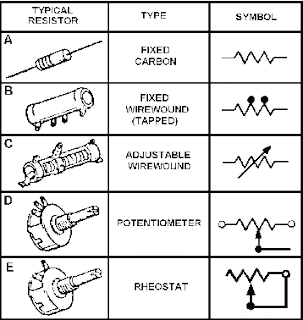Information about
Electronics:
In this blog, I will be
fully explained about resistance and its types.
What is resistance;
Resistance
is the measure of opposition to electric current. A short circuit is an
electric circuit offering little or no resistance to the flow of electrons.
Short circuits are dangerous with high voltage power sources because the high
currents encountered can cause large amounts of heat energy to be released.
How to measure
resistance:
The
resistance value, tolerance, and wattage rating are generally printed onto the
body of the resistor as numbers or letters when the resistors body is big
enough to read the print, such as large power resistors. But when the resistor
is small such as a 1/4 watt carbon or film type, these specifications must be
shown in some other manner as the print would be too small to read.
Calculating Resistor
Values
The Resistor
Colour Code system is all well and good but we need to understand how to apply
it in order to get the correct value of the resistor. The “left-hand” or the
most significant coloured band is the band which is nearest to a connecting
lead with the colour coded bands being read from left-to-right as follows:
Digit,
Digit, Multiplier = Colour, Colour x 10 colour
in Ohm’s (Ω)
For example,
a resistor has the following coloured markings;
Yellow
Violet Red = 4 7 2 = 4 7 x 102 = 4700Ω or 4k7 Ohm.
these
sayings are often very crude but never the less effective for remembering the
resistor colours. Here are just a few of the more “cleaner” versions but many
more exist:
Bad Booze
Rots Our Young Guts But Vodka Goes Well
Bad Boys
Ring Our Young Girls But Vicky Goes Without
Bad Boys
Ring Our Young Girls But Vicky Gives Willingly — Get Some Now (This one is only
slightly better because it includes the tolerance bands of Gold, Silver, and
None).
There are
different types of resistors. Some of these are described below.
·
Wire
wound resistors
·
Metal
film resistors
·
Thick
film and Thin film resistors
·
Network
and Surface Mount Resistors
·
Variable
Resistors
·
Special
resistors
Wire wound resistors;
A wire wound resistor is an electrical passive component that
limits current. The resistive element exists out of an insulated metallic wire
that is winded around a core of non-conductive material. ... They can be
produced very accurate, and have excellent properties for low resistance values
and high power ratings.
Symbol of wire wound resistance :
Metal film resistor;
Metal film resistors have a thin metal layer as resistive
element on a non-conducting body. They are amongst the most common types of axial
resistors. Other film type resistors are carbon film and thick and thin film
resistors. In most literature referrals to metal film, usually it is a
cylindrical axial resistor.
Thick film and Thin
film resistors;
Thin film has a thickness in the order of 0.1 micrometer or
smaller, while thick film is around thousands time thicker. However, the main
difference is method the resistive film is applied onto the substrate. Thin
film resistors have a metallic film that is vacuum deposited on an insulating
substrate.
Network and surface
mount resistor;
Resistor networks also known as resistor arrays feature
multiple resistors connected together in a circuit pattern. They primarily act
as a voltage divider, which split the voltage in a circuit to smaller amounts.
Symbol ;
Variable resistor;
Variable resistors are resistors of which the resistance
value can be adjusted, the most common types are a potentiometer, rheostat or
digital resistor.
Symbol ;
Special resistors ;
Resistors. Resistors restrict or limit the flow of current in
a circuit. The ability of a material or component to resist current flow is
measured in ohms. ... variable resistors. special resistors, such as
thermistors and light-dependent resistors (LDRs)












Amazing post and it's very informative for us Thanks for sharing and if you are looking for graphtec data loggers check here
ReplyDeletedata logger Distributor
data logger Dealers